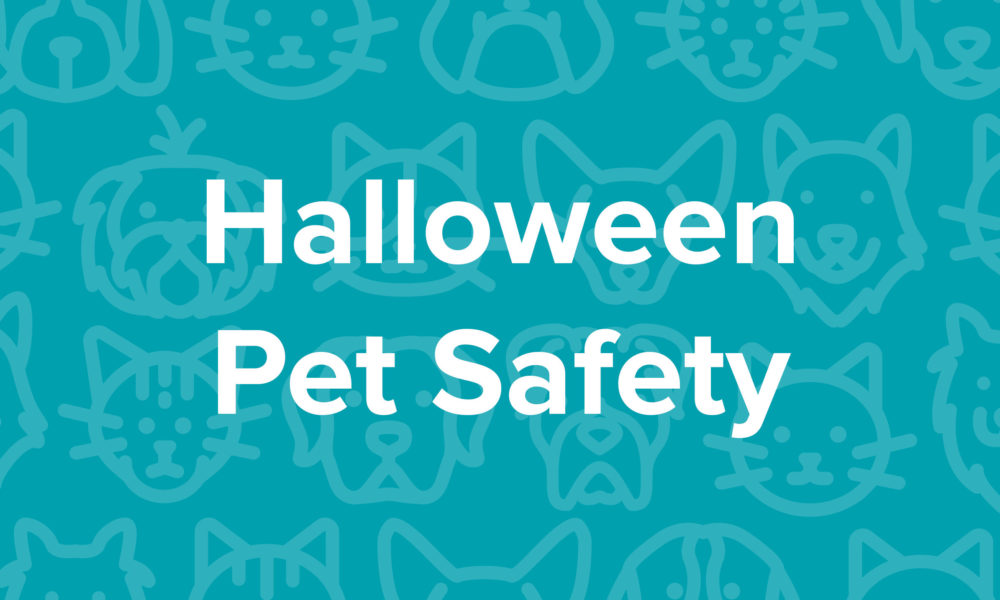Halloween Pet Safety

Halloween will be here soon. Here are some things that pet parents should do to keep pets safe:
If you live in a neighborhood that has a lot of trick or treaters, Halloween can be stressful for pets with the doorbell ringing, the door opening and closing, and kids yelling, ‘trick or treat!’ It’s best to keep your pets in a separate room while trick or treating is happening and make sure they are wearing a collar with identification tags and that their microchip information is up to date in case they decide to run out the door and do a bit of trick or treating themselves! If the weather is nice, consider sitting outside to give out treats to avoid that repeated doorbell ringing.
If you are going out trick or treating, it’s best to leave your dog at home. They may look cute in their costume, but other costumes can scare them! If you are carrying a glow stick while trick or treating, pets think they are fun toys once you bring them home, but they can puncture the plastic and ingest the liquid inside. The liquid is non-toxic but tastes bitter, causing drooling and upsetting your pet. If they do ingest some of the liquid, give them a pet treat or a little milk to get the taste out of their mouth.
This year, like last, some communities may not participate in trick or treating, or families may choose to have a Halloween party at home with family and close friends. If you have people coming and going to your house, it’s still a good idea to keep your pets in a separate room and wear their identification tags so they don’t slip out to find their own Halloween fun! Your pets may also be scared of some peoples’ costumes and try to get away from those zombies and vampires!
Don’t leave your pets out in the yard on Halloween to become victims of pranksters or thieves. Black cats are especially at risk so if you have a black cat, keep them indoors.
When decorating your house for Halloween, keep candles out of reach, or better yet, use flameless, battery-operated candles – they are safer and can be just as spooky! Of course, keep the batteries away from your pets as they can cause chemical burns if chewed or swallowed. If you use stringed lights, keep the wires out of reach – some pets just love to chew on them. Be careful with any scented decorations because these can be toxic to birds. If you have spooky decorations that make noises, have flashing lights, or make sudden movements (like a skeleton jumping out of a closet – oh, I get scared just thinking about that!), these may cause extra stress for some pets so using them less often or keeping your pets away from them is probably a good idea.
Some Halloween and fall decorations can also be toxic to pets. Some, like pumpkins or decorative corn cobs, can cause stomach upset if your pets nibble on them, especially when those pumpkins start to get moldy and rotten. Some types of mold produce toxins that cause neurological problems in pets.
If you want to dress your pet in a costume for Halloween, be sure this is something that they don’t mind. Try the costume on your pet ahead of time and if they seem anxious or upset, opt for a Halloween neck scarf or bow tie instead. If your pet doesn’t mind wearing a costume, be sure that the costume fits well and doesn’t restrict their movements, breathing, vision, or hearing. It shouldn’t drag on the ground which can cause tripping. Also, be sure the costume doesn’t have small pieces that can be chewed off and become a choking hazard.
You want your pet to enjoy Halloween as much as you do, but do not give them any candy treats meant for humans, especially chocolate. Chocolate, dark chocolate, in particular, is toxic for cats and dogs. Sugar-free candy contains xylitol (a sugar substitute) that can cause seizures and liver failure in dogs. If you think your pet has eaten something that may be toxic, call your veterinarian or the ASPCA Poison Control Center (888-426-4435) immediately. If you are planning on giving out more healthy treats, remember that raisins can cause kidney failure, and pumpkin seeds, while not toxic, can cause stomach upset in some smaller animals.
